Paranthropus boisei
Online Biology Dictionary
|
|
EUGENE M. MCCARTHY, PHD
|
Now the Ethiopians, as historians relate, were the first of all men.
—Diodorus Siculus
Bibliotheca historica, Book 3.2.1 |
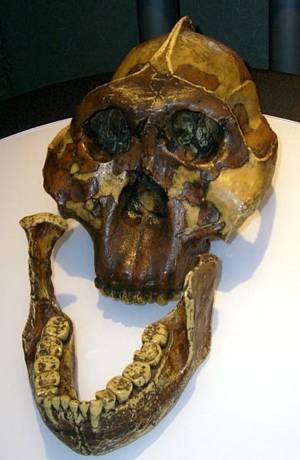
|
|
Paranthropus boisei Credit: Durova |
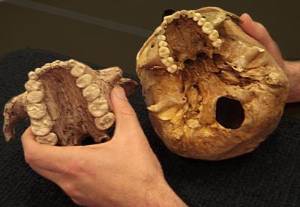
|
|
Two palates showing the large size of the teeth of Paranthropus boisei (left), popularly known as Nutcracker Man. The much smaller teeth of a modern human are shown at right. Credit: Melissa Lutz Blouin, University of Arkansas |
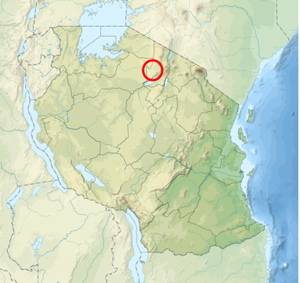
|
|
Location of Olduvai Gorge Map: Sémhur |
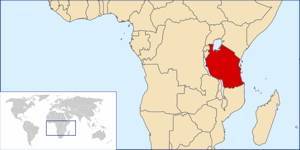
|
|
Location of Tanzania Map: Vardion |
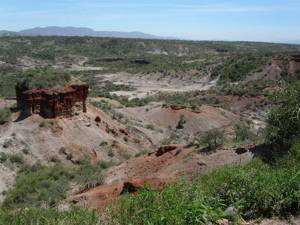
|
|
Olduvai Gorge Map: Guston Sondin-Klausner |
Fossils attributed to this hominid range from about 1.1 to 2.6 million years in age (early to middle Pleistocene) and come from eastern Africa.
Mary Leakey, the wife of Louis Leakey, discovered the first specimen of Paranthropus boisei, a well-preserved cranium, on July 17, 1959, at Olduvai Gorge, Tanzania (then Tanganyika). Louis was laid up in camp at the time with a fever. But, truth to tell, even if he had been in better shape, it's unlikely he'd have found it — Of the two, Mary did far more of the hands-on work of fossil discovery. Louis was the intuitive member of the pair. He picked the likely sites. Mary did most of the digging.
Dating to 1.75 mya, the skull was the first robust australopithecine ever found and did much to convince the scientific world that Darwin and Raymond Dart had been right about their claims of Africa being the earliest scene of human evolution. A replica of the skull (and of a jaw found separately by Kamoya Kimeu in 1964) is shown at right.
Initially, this hominid was assigned the name Zinjanthropus boisei, but was later renamed Australopithecus boisei. In recent years it has often placed in the genus Paranthropus, since it is one of the robust australopithecines (given the sturdy chewing-related features of its skull).
The cranial capacity of Paranthropus boisei was 500-550 cc — about the same as that of a typical gorilla. Moreover, its skull exhibits various other gorilla-like traits — a robust jaw, sagittal crest, heavy postcanine teeth, thick tooth enamel, and a flaring zygomatic arch (PICTURE OF GORILLA SKULL) — But the canines and incisors are similar to a human's (see figure at right).
Paranthropus boisei is nicknamed "Nutcracker Man" because it has the largest molars of any known hominid, which is fairly obvious in the figure. Their grinding surface is over twice as large as that of a modern human.
Males stood 1.3 meters (4 feet 3 inches) tall and weighed about 70 kilograms (154 pounds). Females weighed just 45 kilograms (about 100 pounds) and were only about 1.05 meters (3 feet 5 inches) in height.
This hominid may have used shaped stone tools, albeit crude ones — little more than broken pebbles with sharp edges. However, this is controversial — the tools in question might have been the products of contemporaneous Homo.
It is still uncertain how the paranthropines are related to modern humans. Some maintain they were our direct ancestors. But their contemporaneous existence with early representatives of the genus Homo casts this claim in doubt. (Indeed, given modern trends in evolutionary theory, it may well turn out that the best way to describe human evolution is in terms of a web rather than a tree.)
Perhaps the greatest significance of Paranthropus boisei is that its 1959 discovery convinced the scientific world that the place to look for the earliest humans is Africa.
Perhaps we are not from the apes alone?
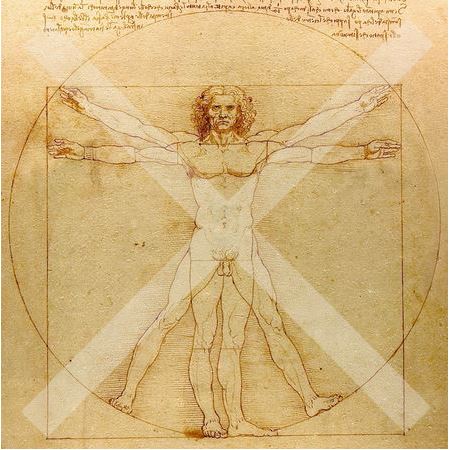
|
Facts about Paranthropus boiseiHabitat: Savanna. Diet: A tough-to-chew diet of vegetable foods. Synonyms: Australopithecus boisei, Zinjanthropus boisei. Pronunciation: pair-RAN-thrəp-pəs or (PAIR-ən-THRŌPE-pəs) BOY-zee-ī. Etymology: The Greek suffix -anthropus was added to the Greek prefix par- to construct paranthropus, meaning "near man"; the Latin ending -i, meaning "of", was added to last name of one of the Leakeys' funders, Charles Boise, to construct boisei. Classification: Members of the genus Paranthropus, the robust australopithecines, are often assigned to the genus Australopithecus, which otherwise contains only the gracile australopithecines. |
Interesting facts about other members of genus Homo:
Australopithecus bahrelghazali >>
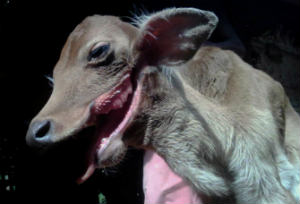 A dog-cow hybrid?
A dog-cow hybrid?